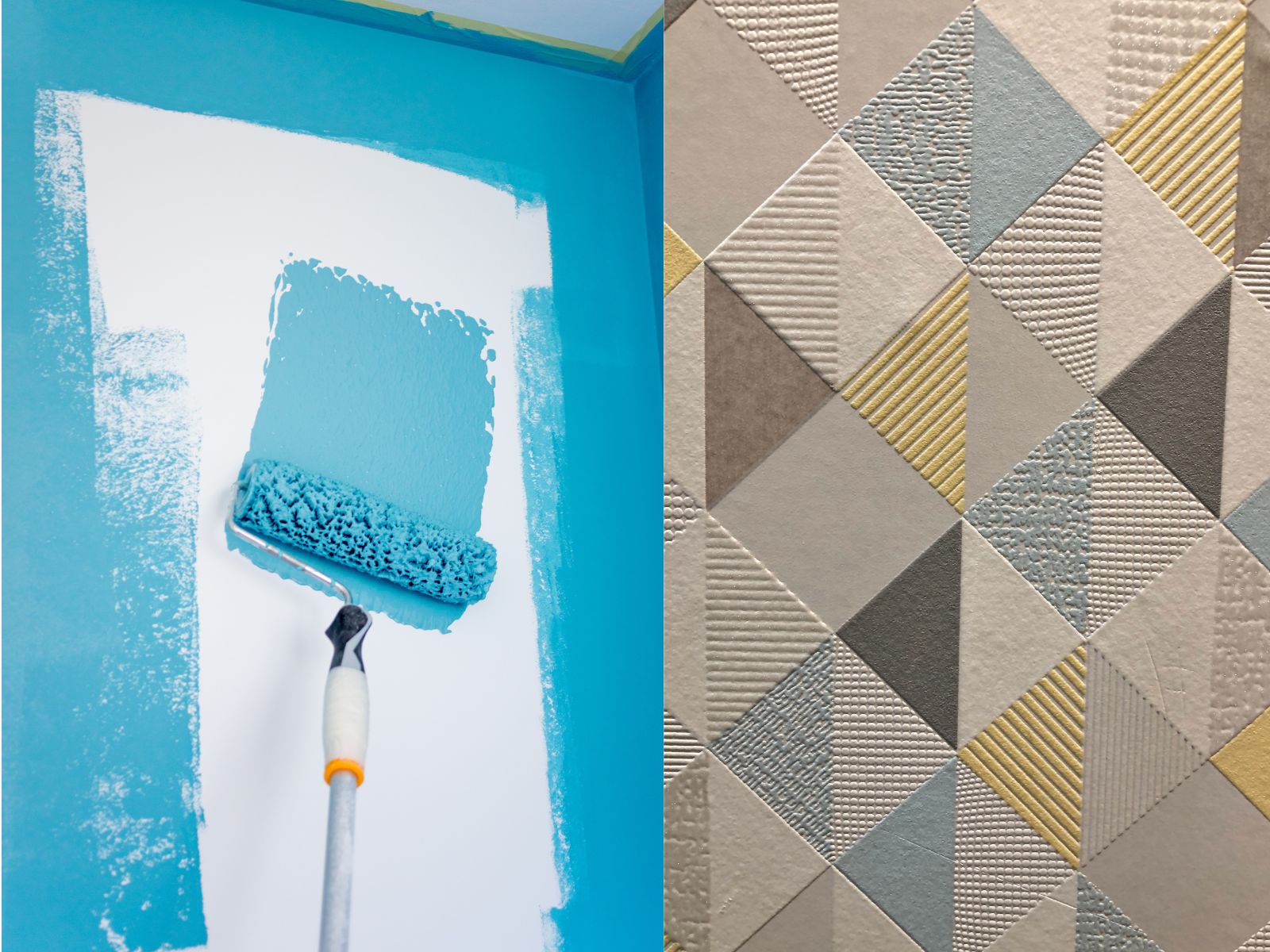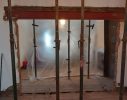Home Refurbishment UK 2024 – Painting and Wallpapering
Adding a Splash of Personality to Your Walls
One of the most transformative and cost-effective ways to breathe new life into your space is by giving your walls a makeover through painting and wallpapering.
This section will guide you through the creative process of adding a splash of personality to your home.

LAST UPDATED: MARCH 01, 2024
Table of content
USEFUL LINKS / CALCULATORS
Choosing Your Color Palette
Selecting a color palette for your home is akin to choosing the wardrobe for your living space.
It’s an opportunity to infuse each room with personality, evoke specific moods, and create a cohesive visual story that harmonises with your taste.
1. Dive into this palette-picking adventure with a sense of curiosity and a brush dipped in creativity.e
-
Consider your personal style as the guiding force behind your color choices. Are you drawn to the serene tranquility of neutral tones, or does your heart skip a beat for bold and vibrant hues? Your home is an extension of your personality, so let the colours reflect your unique taste and preferences.
2. Room-by-Room Symphony:
-
Recognize that each room in your home has its own narrative. The bedroom might be your sanctuary, inviting soft and soothing tones, while the living room may crave energetic and lively colors for social gatherings. Craft a color symphony that complements the purpose and ambiance of each space.
3. Inspiration from the Environment:
-
Look to the environment around you for inspiration. Nature, with its endless palettes, can be a muse for creating harmonious color combinations. Whether it’s the calming blues of the ocean or the earthy tones of a forest, draw inspiration from the world outside your windows.
4. Playing with Light and Space:
-
Understand the role of light and space in influencing color perception. Darker colors can add coziness to larger rooms, while lighter tones can make smaller spaces feel more expansive. Consider the natural light that enters each room and how it interacts with your chosen colours throughout the day.
5. Creating Emotional Resonance:
-
Colors have the power to evoke emotions. Reds and oranges can add warmth and energy, while blues and greens promote calmness. Infuse your color palette with the emotional resonance you want to experience in each room. Imagine the feelings you want to evoke as you step into each space.
6. Harmonising with Existing Elements:
-
Take note of existing elements in your home – furniture, flooring, and architectural features. Your color palette should harmonise with these elements rather than clash. Consider whether to complement or contrast with the existing components, ensuring a balanced and visually appealing composition.
7. Sampling and Testing:
-
Don’t be afraid to sample your chosen colors on a small section of your walls. The way a color looks on a paint swatch may differ under your home’s lighting conditions. Testing allows you to see how the colors interact with your space, ensuring you’re pleased with the final result.
8. Considering the Long-Term:
-
While trends can be tempting, think about the longevity of your chosen colors. Trends come and go, but a timeless color palette can provide a backdrop for changing decor and personal preferences over the years. Strike a balance between current trends and enduring appeal.
9. Expressing Creativity with Accents:
-
Beyond the main wall colors, consider the creative expression of accent colours. These can be introduced through furniture, decor items, or even painted accent walls. Accents provide a playful opportunity to infuse additional personality and flair into your living spaces.
10. Personal Connection and Intuition:
-
Trust your personal connection and intuition when finalising your color palette. Your home is a canvas for self-expression, and the colors you choose should resonate with you on a visceral level. Whether it’s a nostalgic hue from your childhood or a modern shade that sparks joy, let your instincts guide your choices.
**Choosing a colour palette for your home is not just about aesthetics; it’s about creating an emotional tapestry that weaves through the fabric of your daily life.
Immerse yourself in the world of colors, experiment with shades that speak to you, and watch as your home transforms into a canvas of your own making, painted in hues of personality and warmth.
Experiment with Accent Walls
The concept of accent walls is your passport to adding drama, flair, and a touch of the unexpected to your living spaces.
It’s the design equivalent of a captivating plot twist, transforming a room into a visual narrative that commands attention.
Embark on this creative journey of experimentation and discover how accent walls can redefine the character of your home.
1. Selecting the Focal Point:
-
Before choosing a wall to accentuate, identify the natural focal points in each room. This could be a fireplace, a prominent architectural feature, or the wall opposite the entrance. Accentuating these areas amplifies their significance, drawing the eye and creating a sense of balance.
2. Choosing the Right Wall:
-
While any wall can become an accent, choosing the right one is crucial. Opt for walls that naturally catch your eye or those that can benefit from a splash of color or texture. Avoid overwhelming the space by selecting just one or two walls per room for this distinctive treatment.
3. Playing with Color Dynamics:
-
The magic of accent walls lies in the color dynamics they introduce. Consider bold and contrasting colors that stand out against the room’s main color palette. This is your chance to be adventurous – think deep jewel tones, rich earthy hues, or even vibrant patterns that add depth and intrigue.
4. Texture as a Visual Feast:
-
Beyond color, experiment with texture to create a tactile feast for the eyes. Textured wallpapers, faux finishes, or even strategically placed paneling can transform an accent wall into a three-dimensional masterpiece. The interplay of light and shadow adds an extra layer of visual interest.
5. Creating Geometric Drama:
-
Geometric patterns can inject a sense of modernity and sophistication. Consider geometric accent walls with stripes, chevrons, or herringbone patterns. The precision of these designs not only adds visual appeal but also defines the space with a touch of contemporary elegance.
6. Embracing Murals and Wall Art:
-
Turn your accent wall into a canvas for self-expression by embracing murals or wall art. From nature-inspired scenes to abstract designs, murals offer a personalized touch that transforms your space into a curated gallery. This is an excellent way to reflect your unique taste and passions.
7. Accentuating with Textiles:
-
Extend the concept of accent walls beyond paint and wallpaper by introducing textiles. Hang a bold tapestry, create a gallery wall with eclectic artwork, or use fabric panels to add warmth and softness. This dynamic approach allows for versatility and can be easily updated to suit changing tastes.
8. Lighting Enhancements:
-
Illuminate your accent wall strategically to enhance its impact. Consider focused lighting fixtures, such as sconces or spotlights, to draw attention to the wall’s features. Play with the interplay of light and shadows to create a captivating visual effect, especially during the evening hours.
9. Reflective Surfaces for Glamour:
-
Introduce glamour and sophistication with reflective surfaces. Mirrored tiles, metallic paints, or even strategically placed mirrors can elevate your accent wall, adding a touch of luxury and creating the illusion of expanded space.
10. Consistency in Design Theme:
-
While experimenting with accent walls, maintain a consistent design theme with the rest of the room. The goal is to enhance, not disrupt, the overall aesthetic. Ensure that the chosen colors, patterns, and textures harmonise with the existing decor for a cohesive and polished look.
**Experimenting with accent walls is not just about adding colour; it’s about crafting a visual narrative that reflects your personality and design sensibilities.
Approach this creative endeavor with an open mind, let your imagination run wild, and witness how a single wall can transform the entire atmosphere of a room, turning it into a space that tells a story uniquely yours.
Keep in mind that the allure of saving a few pounds by opting for a less reputable painter can translate into substantial future expenses.
Choosing a qualified and professional tradesman is an integral part of a cost-effective and enduring home refurbishment.
Prepare Your Surfaces
Before you embark on the exhilarating journey of colour and creativity, preparing your surfaces for a painting is akin to priming a canvas for a masterpiece.
The meticulous attention you give to this phase sets the stage for a smooth and enduring finish.
Think of it as the foundation of a structure – solid, even, and ready to carry the weight of your design aspirations.
1. Fill the Cracks, Mend the Flaws:
-
Begin your surface preparation by conducting a careful examination. Identify any cracks, holes, or imperfections on the walls. These are the nuances that, once tended to, will ensure your paint or wallpaper application is flawless. Use a high-quality filler to patch up these imperfections, allowing your surfaces to breathe anew.
2. Sanding for a Seamless Touch:
-
Sanding is the unsung hero of surface preparation. It not only smoothens rough areas but also ensures better adhesion for paints and wallpapers. Invest in the right grit sandpaper and gently sand the surfaces, creating a uniform canvas that’s ready to absorb the transformative layers of colour or texture.
3. Cleanliness as a Virtue:
-
A clean canvas is a virtuous canvas. Before you dive into the world of color, ensure your surfaces are free from dust, dirt, and grease. Use a mild cleaning solution and a soft cloth to wipe down the walls, ceilings, or any surface that’s about to undergo a metamorphosis. A clean surface ensures better paint adherence and a longer-lasting finish.
4. Protecting the Uninvolved:
-
While preparing surfaces, be mindful of the elements you don’t want to be part of the makeover. Cover and protect furniture, floors, and fixtures with drop cloths or plastic sheets. This not only safeguards your belongings from accidental spills but also allows you to work freely without worrying about collateral damage.
5. Tape for Clean Edges:
-
Achieving clean, crisp lines is an art in itself. Use painter’s tape to mask off areas where you want clean edges, such as along baseboards, window frames, or ceilings. This simple yet effective technique ensures that your paint doesn’t stray beyond its designated canvas, resulting in a polished and professional finish.
6. Prime for Longevity:
-
Think of primer as the foundation of your design symphony. Applying a high-quality primer creates a uniform surface, enhancing paint adhesion and promoting durability. Primer also acts as a barrier, preventing stains or colors from the previous surface from bleeding through. Choose a primer that suits the specific needs of your surfaces.
7. Test for Compatibility:
-
Before fully committing to a primer or paint, conduct a small test area to ensure compatibility. This is especially important if your walls have been previously painted or treated. Testing allows you to observe how the surface reacts to the chosen products and ensures that your final finish will be cohesive and long-lasting.
8. Mind the Details:
-
Don’t overlook the details during surface preparation. Attend to areas around light switches, outlets, and corners with care. Use smaller brushes or tools to navigate these intricate spaces, ensuring that every nook and cranny receives the attention it deserves.
9. Timing is Everything:
-
Be mindful of the weather and environmental conditions during the preparation phase. Ensure proper ventilation to aid drying and curing processes. Avoid painting or priming in extremely humid or cold conditions, as these factors can affect the quality of the finish.
10. Patience as a Virtue:
-
Surface preparation is not a race but a journey of patience. Allow ample time for fillers, primers, and paints to dry between applications. Rushing this process can compromise the quality of your refurbishment project. Exercise patience, and you’ll be rewarded with a finish that stands the test of time.
**Prepping your surfaces is an act of respect for the canvas that holds the dreams of your design vision.
By dedicating time and attention to this foundational phase, you ensure that your surfaces become a canvas that seamlessly accepts the strokes of color, texture, and creativity you’re about to unleash.
It’s the art of preparation that transforms your home into a masterpiece of your making.
Keep in mind that the allure of saving a few pounds by opting for a less reputable painter can translate into substantial future expenses.
Choosing a qualified and professional tradesman is an integral part of a cost-effective and enduring home refurbishment.
Explore Wallpaper Options
When it comes to transforming your living space, few elements can rival the transformative power of wallpaper.
It’s not merely a covering for your walls; it’s a tapestry that tells a story, setting the tone for the entire room.
As you embark on the exploration of wallpaper options, consider this journey as an artistic adventure, an opportunity to infuse your home with patterns, textures, and visual narratives that resonate with your unique style.
1. Understanding Wallpaper Types:
-
Wallpaper comes in a variety of types, each with its own charm and application. From traditional paper wallpapers to vinyl, fabric, and even peel-and-stick options, understand the characteristics of each type. Consider factors such as durability, ease of installation, and maintenance requirements to choose the wallpaper that best suits your needs.
2. Embracing Patterns with Personality:
-
Patterns are the soul of wallpaper, offering an endless array of possibilities. Whether you’re drawn to classic stripes, intricate florals, geometric shapes, or bold abstract designs, let your personality shine through your pattern choice. Consider the room’s purpose and ambiance when selecting patterns – calming for bedrooms, energising for living spaces, and so on.
3. Textured Elegance:
-
Textured wallpapers add a tactile dimension to your walls, creating an elegant and sophisticated look. From subtle embossed patterns to more pronounced textures like grasscloth or silk, the tactile appeal of textured wallpaper invites touch and adds depth to your space. Consider where textured elegance can make the most impact – perhaps as an accent wall or in a cozy reading nook.
4. Murals for Artistic Expression:
-
Murals take wallpaper to the level of fine art. Choose a mural that resonates with your interests, whether it’s a nature scene, cityscape, or abstract artwork. Murals provide an excellent opportunity to express your artistic sensibilities, turning a wall into a captivating focal point that tells a visual story.
5. Peel-and-Stick Convenience:
-
Peel-and-stick wallpapers have revolutionised the wallpaper game, offering a convenient and temporary solution for those who love to change their decor. Easy to install and remove, these wallpapers are ideal for renters or anyone who enjoys frequent design updates. Explore a wide range of peel-and-stick designs, from subtle textures to bold prints.
6. Coordinate with Existing Elements:
-
When selecting wallpaper, consider how it coordinates with existing elements in the room. Harmonize the wallpaper with your furniture, flooring, and decor to create a cohesive and balanced aesthetic. Whether you choose complementary or contrasting patterns, ensure that the overall look is visually appealing.
7. Consider the Room’s Size:
-
Wallpaper has the power to visually alter the perception of space. In smaller rooms, opt for lighter colors and smaller patterns to create a sense of openness. Conversely, in larger rooms, you can experiment with bolder patterns and darker hues without overwhelming the space.
8. Balancing Busy and Subtle:
-
Strike a balance between busy and subtle patterns based on the room’s purpose. While a bold and busy pattern can make a statement in a living room, a more subtle and subdued design might be preferable in a bedroom where relaxation is the priority. Consider the energy you want each space to exude.
9. Customisation with Borders and Panels:
-
Get creative with borders and panels to customise your wallpaper installation. Borders can frame a room or highlight architectural features, while panels can create a wainscoting effect or draw attention to a specific area. These design elements allow for personalisation and can break up larger expanses of wallpaper.
10. Quality Matters:
-
Invest in quality wallpaper to ensure longevity and a professional finish. Higher-quality wallpapers often have better durability, are easier to clean, and offer a more luxurious look and feel. Consider your wallpaper as an investment in the overall aesthetic and ambiance of your home.
**Exploring wallpaper options is an adventure in self-expression, where your walls become the canvas for your creativity.
Embrace patterns, textures, and designs that resonate with your style, and watch as your home transforms into a gallery of your personal taste and visual storytelling.
The journey of wallpapering is not just about covering walls; it’s about crafting an immersive and personalised atmosphere that reflects the essence of you.
Keep in mind that the allure of saving a few pounds by opting for a less reputable painter can translate into substantial future expenses.
Choosing a qualified and professional tradesman is an integral part of a cost-effective and enduring home refurbishment.
Quality Painting Supplies
Embarking on a painting project is not just about selecting the perfect hue; it’s about wielding the tools of transformation with skill and finesse. Investing in high-quality painting supplies is akin to assembling an artisan’s toolkit, ensuring that every stroke is precise, every line is clean, and the final masterpiece is a seamless reflection of your vision. Let’s delve into the world of painting supplies, where each tool is a brushstroke in the canvas of your refurbishment journey.
1. Brushes as Precision Instruments:
-
Brushes are the artisan’s precision instruments, and investing in quality brushes can make a significant difference in the final result. Choose brushes with synthetic or natural bristles based on the type of paint you’re using. Natural bristles work well with oil-based paints, while synthetic bristles are suitable for water-based paints.
2. Rollers for Efficiency and Even Coverage:
-
Rollers are the workhorses of painting, providing efficiency and even coverage. Opt for high-quality rollers with sturdy frames and lint-free covers. The nap length of the roller cover should be chosen based on the texture of your walls – longer nap for textured surfaces and shorter nap for smoother walls.
3. Painter’s Tape for Clean Lines:
-
Painter’s tape is the secret weapon for achieving clean and crisp lines. Invest in quality painter’s tape to mask off areas where you want sharp edges, such as along baseboards, window frames, or ceilings. The adhesive should create a tight seal to prevent paint bleed, ensuring a professional finish.
4. Drop Cloths for Protection:
-
Protecting your floors and furniture is paramount during a painting project. Quality drop cloths made of canvas or heavy-duty plastic provide a protective barrier against spills and drips. Ensure that the drop cloth is positioned securely to cover the entire work area.
5. Paint Trays for Efficiency:
-
A quality paint tray can streamline the painting process, allowing for efficient dipping and rolling. Look for trays with disposable liners for easy cleanup. Consider trays with built-in compartments for holding paint brushes and rollers, keeping your tools organised and within reach.
6. Extension Poles for Accessibility:
-
Extension poles are invaluable for reaching high or hard-to-access areas without the need for a ladder. Invest in a sturdy and adjustable extension pole that can be easily attached to your paint roller. This not only enhances safety but also ensures a consistent finish on walls and ceilings.
7. Quality Paint for Lasting Results:
-
The quality of your paint is a critical factor in achieving lasting and vibrant results. Choose paints with high pigmentation for better coverage. Consider the finish – whether matte, satin, or glossy – based on your desired aesthetic and the room’s functionality. High-quality paints often require fewer coats for complete coverage.
8. Painting Edgers for Efficiency:
-
Painting edgers can be valuable tools for achieving clean lines along edges and corners. Invest in edgers that are easy to maneuver and provide precise results. These tools are particularly useful for cutting in around trim and borders.
9. Paint Scrapers and Sandpaper for Surface Preparation:
-
Surface preparation is key to a flawless finish. Quality paint scrapers and sandpaper help remove old paint, smooth surfaces, and create an ideal foundation for new paint. Invest in scrapers with ergonomic handles for comfortable use and sandpaper with various grits for different applications.
10. Respirators and Safety Gear:
-
Prioritise safety during your painting project by investing in respirators and safety gear. Quality respirators protect against paint fumes and dust, ensuring a healthier working environment. Additionally, wear safety glasses and gloves to shield yourself from accidental splatters and spills.
**Investing in quality painting supplies is not just a matter of convenience; it’s a commitment to the craftsmanship of your refurbishment project.
Each brushstroke, roll, and cut-in line becomes a testament to the thoughtfulness you put into selecting the right tools.
With an artisan’s toolkit at your disposal, your painting project transforms from a task into a creative endeavor, where the result is a masterpiece that reflects the care and precision you poured into every detail.
Keep in mind that the allure of saving a few pounds by opting for a less reputable painter can translate into substantial future expenses.
Choosing a qualified and professional tradesman is an integral part of a cost-effective and enduring home refurbishment.
Experiment with Techniques
Painting your home is not merely an act of covering surfaces; it’s an opportunity to express your creativity and infuse your living spaces with unique character.
Experimenting with painting techniques adds a layer of artistry to your refurbishment journey, turning walls into canvases and rooms into galleries.
Delve into the world of techniques, where each brushstroke becomes a stroke of creative expression.
1. Color Blocking for Bold Statements:
-
Color blocking involves painting geometric shapes or sections of a wall in different colors. This technique allows you to make a bold visual statement and create a dynamic, modern look. Consider using contrasting colours or tones from the same colour family for a harmonious yet impactful effect.
2. Ombre: Gradient Elegance on Your Walls:
-
Ombre, derived from the French word for “shaded,” involves blending colors seamlessly from one hue to another. Create a gradient effect on your walls by transitioning from a lighter shade to a darker one. This technique adds elegance and visual interest, especially when applied to accent walls or focal points.
3. Stencilling for Artistic Precision:
-
Stencilling opens a world of artistic possibilities. Choose a stencil pattern that aligns with your style – whether it’s florals, geometrics, or intricate motifs. This technique allows for precise and repeatable designs, making it a versatile choice for accent walls, borders, or even furniture.
4. Stripes and Patterns for Visual Texture:
-
Painting stripes or patterns adds visual texture and dimension to your walls. Vertical stripes can elongate a room, while horizontal stripes create a sense of width. Experiment with varying stripe widths or patterns to achieve different effects – from classic to contemporary.
5. Sponging for Subtle Texture:
-
Sponging is a technique that imparts a soft and subtle texture to your walls. Dip a natural sea sponge or a synthetic sponge into paint and gently press it onto the wall. This method creates a mottled effect, adding depth and character. Sponging is particularly effective in creating faux finishes that mimic the look of stone or aged plaster.
6. Rag Rolling for Faux Finish Drama:
-
Rag rolling involves rolling a crumpled rag over wet paint to create a textured, faux finish. This technique adds drama and depth, resembling the texture of fabric or aged leather. Experiment with different rag sizes and colors to achieve varied effects, creating a rich and layered appearance.
7. Faux Bois (Wood Graining):
-
Faux bois, or wood graining, replicates the appearance of wood on non-wood surfaces. This technique involves layering paint to mimic the natural grain patterns of wood. Use specialized wood-graining tools or brushes to achieve a realistic wood finish on doors, furniture, or accent walls.
8. Stippling for Artistic Dots and Specks:
-
Stippling involves applying paint with a stippling brush or sponge in a series of dots or specks. This technique creates a textured and artistic effect, adding a touch of whimsy to your walls. Experiment with different colors and densities of stippling to achieve varied results.
9. Trompe-l’oeil: Illusions on Your Walls:
-
Trompe-l’oeil, French for “deceive the eye,” involves creating realistic optical illusions on your walls. This technique can range from faux windows to three-dimensional architectural details. Trompe-l’oeil allows you to bring fantasy and charm to your space, transforming it into a realm of artistic illusion.
10. Combining Techniques for Artistic Fusion:
-
Don’t limit yourself to a single technique; explore the magic of combining different methods. For example, pair color blocking with stenciling, or integrate ombre with stripes. Combining techniques adds complexity and layers to your walls, resulting in a truly unique and personalised finish.
**Experimenting with painting techniques is an invitation to unleash your inner artist. Each technique becomes a brushstroke of creativity, allowing you to mold and shape your living spaces with a distinct and personal touch.
Embrace the joy of exploration, let your imagination soar, and watch as your walls transform into a gallery of your own making, showcasing the artistic essence of your home.
Keep in mind that the allure of saving a few pounds by opting for a less reputable painter can translate into substantial future expenses.
Choosing a qualified and professional tradesman is an integral part of a cost-effective and enduring home refurbishment.
Consider Eco-Friendly Choices
In an era where environmental consciousness is paramount, transforming your living space can be an opportunity to paint a sustainable future.
Consideration of eco-friendly and sustainable options in your refurbishment journey not only contributes to a healthier home but also helps reduce your ecological footprint.
Let’s explore the brushstrokes of sustainability, where each choice becomes a step towards a greener, more mindful home.
1. Low-VOC or VOC-Free Paints:
-
Volatile Organic Compounds (VOCs) are chemicals found in many traditional paints that can off-gas harmful fumes into the air. Opt for low-VOC or VOC-free paints to minimise indoor air pollution. These eco-friendly alternatives are designed to have lower levels of harmful emissions, creating a healthier indoor environment for you and your family.
2. Water-Based Paints for Minimal Impact:
-
Water-based paints, also known as latex paints, have a lower environmental impact compared to oil-based paints. They contain fewer harmful solvents, dry faster, and are easier to clean up. Choosing water-based paints is a sustainable option that aligns with eco-conscious principles.
3. Recycled Content and Packaging:
-
Check the labels of your chosen paints for recycled content. Some brands incorporate recycled materials into their paint formulations, reducing the demand for new resources. Additionally, consider paints that use recycled or sustainable packaging, minimizing the overall environmental impact of your refurbishment materials.
4. Upcycling Furniture and Decor:
-
Sustainable refurbishment extends beyond paint choices to include the items you choose to update. Consider upcycling existing furniture and decor pieces rather than purchasing new ones. A fresh coat of eco-friendly paint can breathe new life into old furniture, contributing to a circular and sustainable approach to home design.
5. Bamboo or Cork Flooring:
-
If your refurbishment project includes flooring, explore sustainable options such as bamboo or cork. These materials are renewable and grow quickly, making them eco-friendly alternatives to traditional hardwood. Both bamboo and cork offer durability, versatility, and a distinct aesthetic appeal.
6. Natural Fiber Carpets:
-
When selecting carpets or rugs, opt for those made from natural fibers such as wool, jute, or sisal. These materials are biodegradable, renewable, and often sourced from sustainable farming practices. Natural fiber carpets not only contribute to a healthier environment but also add warmth and texture to your living spaces.
7. Energy-Efficient Lighting:
-
As part of your refurbishment, consider updating lighting fixtures to energy-efficient options. LED bulbs, for example, consume less energy, have a longer lifespan, and contribute to overall energy savings. Energy-efficient lighting choices align with sustainability goals and can reduce your home’s energy consumption.
8. Reclaimed Wood for a Rustic Touch:
-
For a rustic and sustainable touch, consider using reclaimed wood in your refurbishment project. Reclaimed wood has a unique character and history, and using it in your design reduces the demand for new timber. Incorporate reclaimed wood in furniture, accent walls, or other decorative elements.
9. Solar Window Treatments:
-
Sustainable window treatments can enhance energy efficiency in your home. Consider solar window treatments that harness natural sunlight while providing insulation. These options contribute to reduced reliance on artificial lighting and heating, promoting a more sustainable and energy-conscious living space.
10. Water-Efficient Fixtures:
-
If your refurbishment extends to bathrooms or kitchens, invest in water-efficient fixtures. Low-flow faucets, showerheads, and dual-flush toilets can significantly reduce water consumption. These fixtures contribute to both water conservation and lower utility bills, aligning with eco-friendly principles.
**Considering sustainable options in your refurbishment journey is a conscious choice to create a home that is not only aesthetically pleasing but also environmentally responsible.
Each sustainable decision becomes a brushstroke in painting a future where homes are designed with mindfulness towards the planet.
Embrace the beauty of sustainable living, and let your refurbished home stand as a testament to the harmony between style and environmental stewardship.
Keep in mind that the allure of saving a few pounds by opting for a less reputable painter can translate into substantial future expenses.
Choosing a qualified and professional tradesman is an integral part of a cost-effective and enduring home refurbishment.
Enjoy the Process
In the rush of our fast-paced lives, the refurbishment of your home is an opportunity to step back, breathe, and savor the process.
Taking your time is not just about completing tasks; it’s about embracing the journey of transformation, appreciating the nuances, and finding joy in each brushstroke.
Let the art of deliberate transformation guide you as you embark on the enriching voyage of refurbishing your living spaces.
1. Set Realistic Milestones:
-
Rather than viewing your refurbishment as a race to the finish line, set realistic milestones. Break down the project into manageable tasks and allocate time for each. This approach allows you to celebrate small victories along the way, turning the process into a series of accomplishments.
2. Create a Relaxing Workspace:
-
Designate a comfortable and well-organised workspace for your refurbishment activities. Whether it’s a corner of a room or a dedicated DIY station, having a thoughtfully arranged workspace enhances efficiency and makes the process more enjoyable. Surround yourself with tools, materials, and inspiration to create a conducive environment.
3. Incorporate Breaks for Reflection:
-
Building in breaks during your refurbishment project is essential for reflection and rejuvenation. Use these pauses to step back, assess your progress, and reflect on the aspects you enjoy most. Taking moments of respite contributes to a positive mindset and allows you to approach each task with renewed enthusiasm.
4. Engage in Creative Visualisation:
-
Before diving into the practical aspects of refurbishment, engage in creative visualisation. Envision the final look and feel of your transformed spaces. Create mood boards, sketch ideas, and allow your imagination to guide the process. This preliminary step adds a layer of excitement and intention to the refurbishment journey.
5. Celebrate the Learning Curve:
-
Refurbishing your home might involve learning new skills or trying techniques for the first time. Embrace the learning curve as an integral part of the process. Allow yourself the space to make mistakes, learn from them, and celebrate the growth that comes with acquiring new knowledge and skills.
6. Share the Experience with Others:
-
If possible, involve family members or friends in the refurbishment process. Sharing the experience with others not only makes the tasks more enjoyable but also creates lasting memories. Collaborative efforts can bring a sense of camaraderie and turn refurbishment into a shared adventure.
7. Document the Transformation:
-
Capture the journey of transformation by documenting the process. Take photographs or keep a journal detailing the various stages of your refurbishment. Not only does this serve as a visual record of your accomplishments, but it also allows you to appreciate the evolution of your home over time.
8. Immerse Yourself in Inspiration:
-
Immerse yourself in sources of inspiration throughout the process. Explore interior design magasines, online platforms, or visit home improvement stores to gather ideas. Drawing inspiration from diverse sources keeps your creativity flowing and adds an element of discovery to the refurbishment experience.
9. Prioritise Self-Care:
-
Amidst the tasks of refurbishment, prioritise self-care. Get enough rest, stay hydrated, and take breaks when needed. Balancing physical activities with moments of relaxation ensures that you can fully enjoy the process without feeling overwhelmed.
10. Reflect on the Transformation:
-
As you approach the completion of your refurbishment, take time to reflect on the transformation. Stand back and admire the work you’ve done, appreciating the details and the overall ambiance. Reflecting on the journey enhances your sense of accomplishment and allows you to truly enjoy the fruits of your labor.









